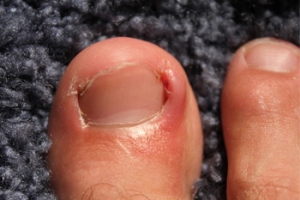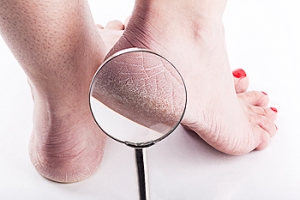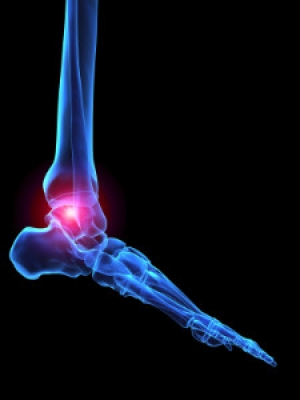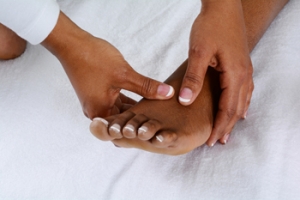
Can Shoes Cause an Ingrown Toenail to Develop?
 A common cause of ingrown toenails is wearing shoes that do not fit correctly. This condition can develop as a result of wearing certain types of shoes that do not have adequate room for the toes to move freely in. An ingrown toenail is defined as a nail that grows into the outer edges of the skin, and can generally cause pain and discomfort. Additional symptoms can include redness, swelling, and pus that may drain from an infected toenail. Moderate relief can be found when the impacted foot is soaked in warm water, which typically helps to soften the skin. It is beneficial to protect the nail by placing a bandage over it as daily activities are completed. If you notice signs of an ingrown toenail, please consult with a podiatrist who can offer correct treatment methods.
A common cause of ingrown toenails is wearing shoes that do not fit correctly. This condition can develop as a result of wearing certain types of shoes that do not have adequate room for the toes to move freely in. An ingrown toenail is defined as a nail that grows into the outer edges of the skin, and can generally cause pain and discomfort. Additional symptoms can include redness, swelling, and pus that may drain from an infected toenail. Moderate relief can be found when the impacted foot is soaked in warm water, which typically helps to soften the skin. It is beneficial to protect the nail by placing a bandage over it as daily activities are completed. If you notice signs of an ingrown toenail, please consult with a podiatrist who can offer correct treatment methods.
Ingrown toenails can become painful if they are not treated properly. For more information about ingrown toenails, contact one of our podiatrists of The Podiatry Center, PC. Our doctors can provide the care you need to keep you pain-free and on your feet.
Ingrown Toenails
Ingrown toenails occur when a toenail grows sideways into the bed of the nail, causing pain, swelling, and possibly infection.
Causes
- Bacterial infections
- Improper nail cutting such as cutting it too short or not straight across
- Trauma to the toe, such as stubbing, which causes the nail to grow back irregularly
- Ill-fitting shoes that bunch the toes too close together
- Genetic predisposition
Prevention
Because ingrown toenails are not something found outside of shoe-wearing cultures, going barefoot as often as possible will decrease the likeliness of developing ingrown toenails. Wearing proper fitting shoes and using proper cutting techniques will also help decrease your risk of developing ingrown toenails.
Treatment
Ingrown toenails are a very treatable foot condition. In minor cases, soaking the affected area in salt or antibacterial soaps will not only help with the ingrown nail itself, but also help prevent any infections from occurring. In more severe cases, surgery is an option. In either case, speaking to your podiatrist about this condition will help you get a better understanding of specific treatment options that are right for you.
If you have any questions please feel free to contact our office located in Millburn, NJ . We offer the newest diagnostic and treatment technologies for all your foot and ankle needs.
Ingrown Toenails
Ingrown toenails (onychocryptosis) are a common foot ailment and it is very unpleasant to experience. The condition is caused by an increase in pressure from the ingrowth of the nail edge into the skin of the toe. Ingrown toenails commonly cause pain in those who experience them. In some cases, the skin surrounding the ingrown toenail may break which may lead bacteria to enter through and cause an infection. Common symptoms of this ailment include pain, redness, swelling, and warmth around the toe.
An imbalance between the size of the nail and the enlargement of the nail skin edge causes ingrown toenails. This condition is often caused by improperly trimming the toenails. If you are trying you cut your nails, you should always try to trim straight across instead of in a rounded shape. Ingrown toenails can also be an inherited condition and they may also be caused by improper shoe fitting.
Another common cause of the condition is wearing shoes that are either too small or too large. Other causes include poor foot hygiene, obesity, diabetes, arthritis, edema, and fungal infections. There are many risk factors that may make a person more likely to develop an ingrown toenail. Athletes who play “stop and start” sports such as tennis, soccer, and basketball are most likely to have ingrown toenails.
People who have diabetes, a compromised immune system, or poor circulation should immediately seek care from a podiatrist if they have an ingrown toenail. It is also recommended to seek professional assistance if at-home remedies are not successful within a week or if there is persistent pain.
Can Wearing Certain Shoes Contribute to Cracked Heels?
 Cracks in the heels are considered to be tears in the epidermis. Common symptoms can include the skin on the heel becoming thick and yellowed, and in severe cases, the cracks, or fissures may begin to bleed. It may gradually develop from standing for extended periods of time during the day, or from wearing shoes that have an open back. These types of shoes can have inadequate cushioning to support the fat pad in the heel, and cracks may form that can be uncomfortable and painful. Patients who are diabetic may be prone to developing this condition, in addition to people who have thyroid disorders. Mild relief may be found when the feet are washed daily, followed by applying a good moisturizer to the affected area. If you would like additional treatment methods for cracked heels, it is suggested that you consult with a podiatrist.
Cracks in the heels are considered to be tears in the epidermis. Common symptoms can include the skin on the heel becoming thick and yellowed, and in severe cases, the cracks, or fissures may begin to bleed. It may gradually develop from standing for extended periods of time during the day, or from wearing shoes that have an open back. These types of shoes can have inadequate cushioning to support the fat pad in the heel, and cracks may form that can be uncomfortable and painful. Patients who are diabetic may be prone to developing this condition, in addition to people who have thyroid disorders. Mild relief may be found when the feet are washed daily, followed by applying a good moisturizer to the affected area. If you would like additional treatment methods for cracked heels, it is suggested that you consult with a podiatrist.
If the skin on your feet starts to crack, you may want to see a podiatrist to find treatment. If you have any concerns, contact one of our podiatrists from The Podiatry Center, PC. Our doctors can provide the care you need to keep you pain-free and on your feet.
Cracked Heels
It is important to moisturize your cracked heels in order to prevent pain, bleeding, and infection. The reason cracked heels form is because the skin on the foot is too dry to support the immense pressure placed on them. When the foot expands, the dry skin on the foot begins to split.
Ways to Help Heal Them
- Invest in a good foot cream
- Try Using Petroleum Jelly
- Ease up on Soaps
- Drink Plenty of Water
Ways to Prevent Cracked Heels
- Moisturize After Showering
- Skip a Shower
- Keep Shower Water Lukewarm
- Don’t Scrub Your Feet
If you are unsure how to proceed in treating cracked heels, seek guidance from a podiatrist. Your doctor will help you with any questions or information you may need.
If you have any questions, please feel free to contact our office located in Millburn, NJ . We offer the newest diagnostic and treatment technologies for all your foot care needs.
Solutions for Cracked Heels
Cracked heels can make life very frustrating and embarrassing when displaying the bare feet. Aside from being unpleasing to the eye, they can also tear stockings and socks and wear out shoes at a faster rate. When severe, cracked heels may cause pain or infection.
Cracked heels are a problem for those who are athletic, those who may walk a lot, and those who have especially dry skin. Those who use medication that dry the skin, those who swim often, wearing certain types of shoes, and those who are diabetic may have trouble with cracked heels. Seniors whose skin produces less oil may also have trouble with cracked feet. There is no one way to develop cracked feet, and there is no cure.
Today, the market consists of numerous products that have a variety of ingredients to promote healing. Some of these are over-the-counter. Others are prescribed by a doctor, especially for those who have chronic dry feet and heels.
Some doctors recommend wearing socks at night for those with rough skin. This helps further healing, and helps creams stay on longer and better absorb into the skin.
One way to alleviate dryness that causes cracked heels is by using moisturizers both day and night. Another way is to make sure the skin is clean and dry at all times. Using a pumice stone to buff away dead skin before putting on moisturizer can also help. Cracked heels will not respond to the cream unless the outer layer of skin is first removed through exfoliation. After exfoliation, lotion or ointment will be absorbed by the skin more easily.
Foods that produce healing and balance can also help the skin from within. Everything that is put into the body can either help it or hurt it. Taking supplements of omega-3 fatty acids and zinc can also be very beneficial.
Nevertheless, not all products are guaranteed to help treat cracked feet. Seeing a professional is best if other treatments options were unsuccessful. A podiatrist should be able to give the best advice to help with this problem.
Possible Signs Of Rheumatoid Arthritis
 The medical condition that is known as rheumatoid arthritis can occur from an immune system that is not functioning properly. It can attack the joints in the body, and can cause severe pain and discomfort. Some of the symptoms that are associated with this ailment can consist of swollen and stiff joints, which can cause difficulty in completing daily activities. Additional signs that patients can notice when this condition first develops can include depression, limited range of motion, and a low-grade fever. When rheumatoid arthritis is promptly treated, damage to the joints and cartilage in the feet may be diminished, and the chances of having a heart attack or stroke may be reduced. If you have a tingling feeling in your feet, it is advised that you confer with a podiatrist who can properly diagnose and treat rheumatoid arthritis.
The medical condition that is known as rheumatoid arthritis can occur from an immune system that is not functioning properly. It can attack the joints in the body, and can cause severe pain and discomfort. Some of the symptoms that are associated with this ailment can consist of swollen and stiff joints, which can cause difficulty in completing daily activities. Additional signs that patients can notice when this condition first develops can include depression, limited range of motion, and a low-grade fever. When rheumatoid arthritis is promptly treated, damage to the joints and cartilage in the feet may be diminished, and the chances of having a heart attack or stroke may be reduced. If you have a tingling feeling in your feet, it is advised that you confer with a podiatrist who can properly diagnose and treat rheumatoid arthritis.
Because RA affects more than just your joints, including the joints in your feet and ankles, it is important to seek early diagnosis from your podiatrist if you feel like the pain in your feet might be caused by RA. For more information, contact one of our podiatrists of The Podiatry Center, PC. Our doctors will assist you with all of your podiatric concerns.
What Is Rheumatoid Arthritis?
Rheumatoid Arthritis (RA) is an autoimmune disorder in which the body’s own immune system attacks the membranes surrounding the joints. Inflammation of the lining and eventually the destruction of the joint’s cartilage and bone occur, causing severe pain and immobility.
Rheumatoid Arthritis of the Feet
Although RA usually attacks multiple bones and joints throughout the entire body, almost 90 percent of cases result in pain in the foot or ankle area.
Symptoms
- Swelling and pain in the feet
- Stiffness in the feet
- Pain on the ball or sole of feet
- Joint shift and deformation
Diagnosis
Quick diagnosis of RA in the feet is important so that the podiatrist can treat the area effectively. Your doctor will ask you about your medical history, occupation, and lifestyle to determine the origin of the condition. Rheumatoid Factor tests help to determine if someone is affected by the disease.
If you have any questions please feel free to contact our office located in Millburn, NJ . We offer the newest diagnostic and treatment technologies for all your foot and ankle needs.
Rheumatoid Arthritis in the Feet
Although rheumatoid arthritis attacks multiple bones and joints throughout the entire body, ninety percent of people who actually develop this condition usually do so in the foot or ankle area. Those who develop this kind of arthritis in the feet usually develop symptoms around the toes and forefeet first, before anywhere else. Rheumatoid arthritis appears to have a genetic component. If it runs in the family, then you will be more likely to develop it as well.
Rheumatoid arthritis is an autoimmune disorder in which the body’s own immune system attacks the lining of the membranes surrounding the joints. This causes inflammation of the membrane lining, and the gradual destruction of the joint’s cartilage and even bone.
Some of the most common symptoms that are associated with RA include pain and swelling of the feet. Stiffness in the feet is also another common symptom that people experience. Those who have RA in the feet usually feel the pain in the ball or sole of their feet. This can get to be very painful at times. A person's joints can even shift and become deformed after a period of time.
In order to properly diagnose RA in the feet it is usually necessary for a doctor or podiatrist to evaluate the area. Your doctor will also question you about your medical history, occupation, etc., to determine whether anything in your lifestyle may have triggered the condition. There are a number of tests that may be performed to help diagnose RA, such as a rheumatoid factor test. There is, however, no one single test that will tell you for sure if you have RA. There are different X-rays that can be taken as well to determine if a person has RA in their feet.
There is a range of treatment options for rheumatoid arthritis. Treatment of RA is usually a lifelong process that includes a variety of methods of treatment and therapy. Your doctor can prescribe special shoes that should help with arch support as well as heel support. A physical therapist can help those with this condition learn exercises which will keep their joints flexible. Surgery may be needed to correct some of the issues with the feet, such as bunions, and hammertoes. Fusion is usually the most successful surgical option for rheumatoid arthritis. However, people need to keep in mind that there are some risks associated with these surgeries.
Different Types of Foot Pain
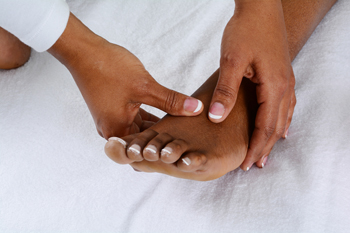 There are several areas in the foot that can feel pain due to specific conditions that may have developed. Heel pain may be indicative of plantar fasciitis and heel spurs, and can cause severe discomfort. Toe pain may signify a bunion, hammertoe, or the arthritic condition that is referred to as gout. A nerve condition that is known as Morton’s neuroma may cause pain in the area between the third and fourth toes, and can be caused by wearing shoes that do not have adequate room for the toes to move freely in. If you are afflicted with any type of foot pain, it is strongly advised that you are under the care of a podiatrist who can diagnose and treat various foot and ankle disorders.
There are several areas in the foot that can feel pain due to specific conditions that may have developed. Heel pain may be indicative of plantar fasciitis and heel spurs, and can cause severe discomfort. Toe pain may signify a bunion, hammertoe, or the arthritic condition that is referred to as gout. A nerve condition that is known as Morton’s neuroma may cause pain in the area between the third and fourth toes, and can be caused by wearing shoes that do not have adequate room for the toes to move freely in. If you are afflicted with any type of foot pain, it is strongly advised that you are under the care of a podiatrist who can diagnose and treat various foot and ankle disorders.
Foot Pain
Foot pain can be extremely painful and debilitating. If you have a foot pain, consult with one of our podiatrists from The Podiatry Center, PC. Our doctors will assess your condition and provide you with quality foot and ankle treatment.
Causes
Foot pain is a very broad condition that could be caused by one or more ailments. The most common include:
- Bunions
- Hammertoes
- Plantar Fasciitis
- Bone Spurs
- Corns
- Tarsal Tunnel Syndrome
- Ingrown Toenails
- Arthritis (such as Gout, Rheumatoid, and Osteoarthritis)
- Flat Feet
- Injury (from stress fractures, broken toe, foot, ankle, Achilles tendon ruptures, and sprains)
- And more
Diagnosis
To figure out the cause of foot pain, podiatrists utilize several different methods. This can range from simple visual inspections and sensation tests to X-rays and MRI scans. Prior medical history, family medical history, and any recent physical traumatic events will all be taken into consideration for a proper diagnosis.
Treatment
Treatment depends upon the cause of the foot pain. Whether it is resting, staying off the foot, or having surgery; podiatrists have a number of treatment options available for foot pain.
If you have any questions, please feel free to contact our office located in Millburn, NJ . We offer the newest diagnostic and treatment technologies for all your foot care needs.
Foot Pain
The feet, being the foundation of the body, carry all of the body’s weight and are therefore prone to experiencing pain and discomfort. If you are experiencing foot pain, it is important to determine where in the foot you are experiencing this pain to help discover the cause of it. While pain can be experienced virtually anywhere in the foot, the most common sites of foot pain are in the heel and ankle.
Heel pain can be due to a multitude of conditions including plantar fasciitis, Achilles tendinitis, and heel spurs. Pain experienced in the ankle can be a sign of an ankle sprain, arthritis, gout, ankle instability, ankle fracture, or nerve compression. In more serious cases, pain in the foot can be a sign of improper alignment or an infection.
Foot pain can be accompanied by symptoms including redness, swelling, stiffness and warmth in the affected area. Whether the pain can be described as sharp or dull depends on the foot condition behind it. It is important to visit your local podiatrist if your foot pain and its accompanying symptoms persist and do not improve over time.
Depending on the location and condition of your foot pain, your podiatrist may prescribe certain treatments. These treatments can include but are not limited to prescription or over-the-counter drugs and medications, certain therapies, cortisone injections, or surgery.
If you are experiencing persistent foot pain, it is important to consult with your foot and ankle doctor to determine the cause and location. He or she will then prescribe the best treatment for you. While milder cases of foot pain may respond well to rest and at-home treatments, more serious cases may take some time to fully recover.
